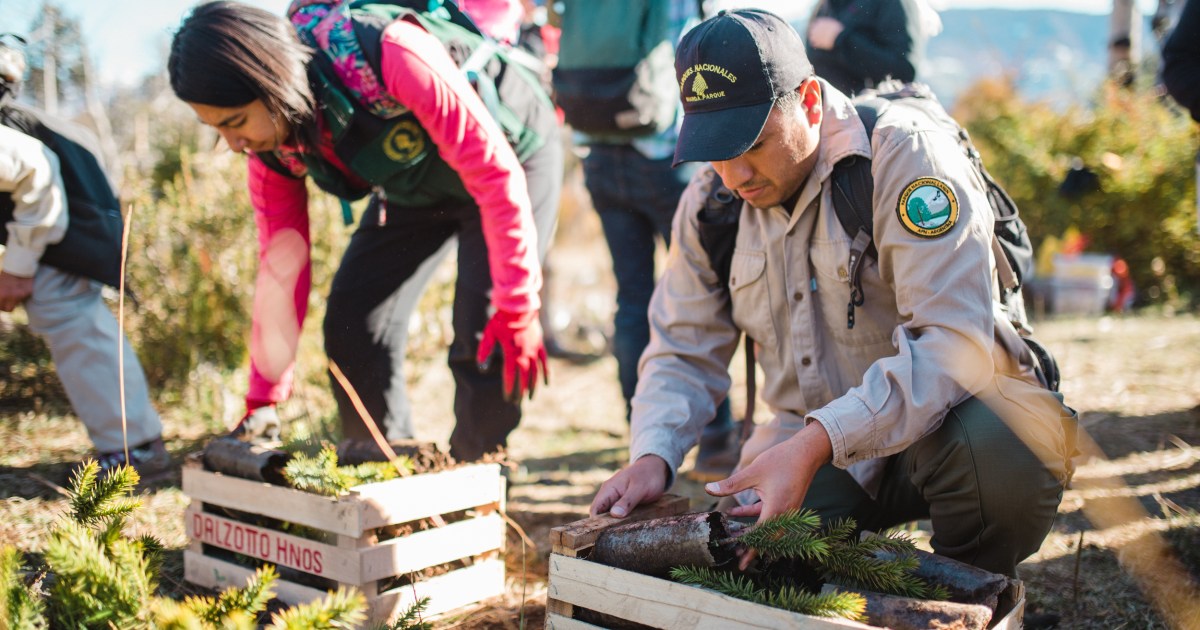In the Lanín National Park, in the province of Neuquén, the strongest restoration in Patagonia is being carried out. It is not the only striking fact: it is also carried out in an associative and participatory manner between volunteers, park rangers, brigade members, technicians, scientific researchers and Mapuche residents.
In three years, more than 19 thousand araucaria seedlings have been planted in the north of the protected area. Este reforestation work is carried out in an area of Lake Ñorquinco thatwhat had been severely affected by a fire alteror more than 1500 hectares in 2013. This is the “Pewen Project”, which – in reality – was conceived 25 years ago when the state of threat faced by the araucaria araucanaalso known as pehuén.
Why the pehuén stands out in the world
The pehuén is an endemic native species, the only one of its kind in the world that lives in a cold temperate climate. Its abundance has decreased significantly in the last 200 years and, currently, there are only 39,000 hectares of araucaria in Argentina and Chile.
The threats are multiple: a long history of deforestation, increasingly frequent and severe fires in Patagonia, the impact of exotic mammals that consume the seed, and livestock farming that alters the habitat and affects soil conditions. Climate change also impacts this ecosystem.
“Today we see that the forest is in decline due to heat waves. It’s drying up. We see that the way the araucaria produces seeds changes. The trees grow less than before and there is more mortality from the regeneration of the seedlings that try to survive,” described the doctor in biology, Javier Sanguinettiworker at Parque Lanín since 1995 and leader of the Pehuén project.
what andconservation strategies are used
Faced with the delicate conservation scenario, he Park National Lanín and the National Institute of Agricultural Technology (INTA) in Bariloche they had startadoeThe Pewen Program in year 1999. The objective was to generate information on the conservation status of these forests and the problems they faced in designing lines of research.
The program is managed by a consortium made up of the Lanín park, the Pewenche Zonal Council, the Propatagonia civil association, the Pulmarí Interinstadual Corporation, the Undersecretariat of Production and the Neuquén Forests Directorate.
In the initiative called Project Pewen, everyone from park rangers to scientists and Mapuche residents collaborate. Photo: Lanín National Park
After 24 years of inter-institutional and international collaborative work, scientific knowledge was generated about cultural and genetic aspects, seed production and interaction of native fauna with the piñon, disturbances such as fire and the forest’s ability to recover, changes induced by biological invasions and climate change.
Three years ago, The Pewen Project obtained funding from the Foundation Franklinia, from Switzerland, which supports conservation proposals for trees categorized as “endangered” by the International Union for Conservation of Nature (IUCN). The pehuen has been on that list since 2012. “We applied to that funding source, we competed with thousands of proposals and we were selected,” Sanguinetti explained.
In 2021, the technicians set themselves the challenge of ecological restoration of the areas affected by the fires in the Tromen Provincial Park area in 2009 and four years later, in Ruca Choroi and Lake Ñorquinco..
“As a result of these fires, a pehuén conservation project emerged that links science with management. “The researchers provide information to those of us who make decisions to restore the site,” said Sanguinetti.
The program develops multiple applied research projects together with other institutions, such as Conicet, the Argentine Institute of Nivology, Glaciology and Environmental Sciences (Ianigla), the Biodiversity and Environment Research Institute (Inibioma) and universities in Chile, France and USA.
The project seeks to restore areas of the araucaria forest that were affected by fires, among other objectives. Photo: Lanín National Park
Scientific findings
“We have been generating an articulation network to generate scientific knowledge that is applied to conservation, to genetic heritage, to natural disturbances, such as fires, or to the production of araucaria seeds,” Sanguinetti defined.
He highlighted that the Argentine Institute of Nivology, Glaciology and Environmental Sciences (IANIGLA), of Mendozastudied the factors that cause more tree mortality, how climate change is affecting growth and what places will be difficult to recover since there is no possibility of trees growing in those places.
Another discovery corresponded to the Inibioma researcher Marcelo Castro who detected that when sowing them “lying down” (and not on their ends), the seeds germinate and grow faster. “Hereinafter, nurseries that produce plants intended for restoration can sow the seeds lying down and we have a plant in eight months. Before it took us two years. It is a clear example of how science can help conservation and management,” explained Sanguinetti.
It was also discovered that Plants have a better chance of surviving if they are placed next to fallen logs. Based on this knowledge, the volunteers are instructed to place the seedlings only in certain places in the forest.
On the other hand, given that the burned areas are affected by livestock farming, until now mainly araucaria had been planted since the animals do not consume it. The technicians defined the places where fences were placed to prevent the animals from entering. “Cows do not eat pehuenes, but they can step on them and damage them. Now, with the new infrastructure, we were able to start planting another species greatly affected by the fire, the coihue. This plant is very sensitive to livestock because they eat it,” said Sanguinetti.
